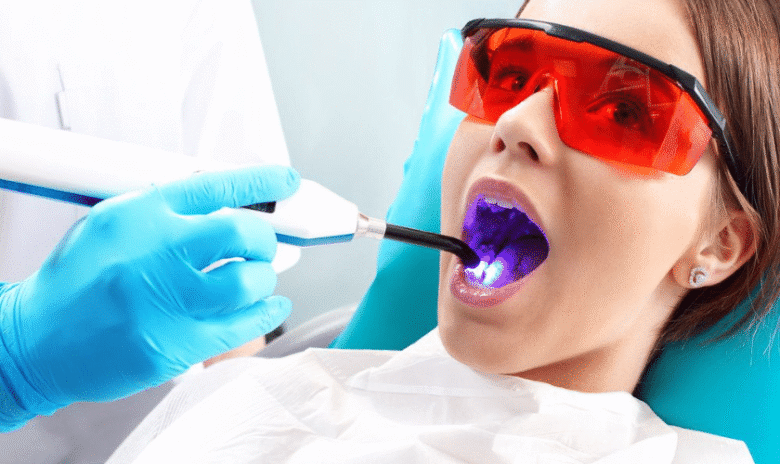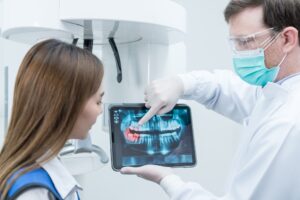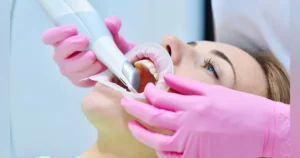Laser dentistry is a recent development that has changed the way dental procedures are performed. Laser devices use focused beams of energy, allowing dentists to perform various treatments more precisely, with less discomfort and a shorter recovery time. These lasers can treat both soft tissue (gums) and hard tissue (teeth, bones). As more and more dental practices use laser technology, patients can expect safer and more comfortable dental care. This innovative procedure is especially interesting for people who are nervous about visiting the dentist or who feel uncomfortable with conventional treatments.
How Does Laser Dentistry Work?
Laser dentistry uses a highly focused beam of light to treat various dental problems. The laser works by vaporizing tissue, changing it, or removing the affected parts of the tooth. It is extremely precise, allowing dentists to target only the injured or infected areas while sparing the surrounding healthy tissue. This makes it an excellent tool for delicate procedures that require precision. Laser settings can be adjusted depending on the treatment, ensuring the best possible results for each patient. The technology also reduces the need for traditional equipment such as drills and scalpels.
Relieves Pain and Discomfort
One of the most important benefits of laser dentistry is the reduction in discomfort during and after dental procedures. Many patients who undergo laser treatment report little to no pain. The result is a significant improvement over traditional treatments. This is especially helpful for patients who are afraid of the dentist or of needles and drills. Often, anesthesia can be reduced or even eliminated. Because the laser causes less tissue damage, there is less edema, bleeding, and sensitivity after treatment, making recovery more comfortable.
Faster Healing and Recovery Time
Laser dentistry can accelerate the healing process compared to traditional techniques. Lasers burn while cutting, which reduces bleeding and the risk of infection. Lasers also help surrounding tissues heal faster. Patients who undergo laser treatment generally recover faster and are able to return to their normal activities more quickly. This is a major benefit for people who need less time for work, school, or daily responsibilities. In addition, less trauma to the gums and other tissues significantly reduces postoperative discomfort.
More Precise, Accurate Treatment
One significant reason for the growing popularity of laser technology in dentistry is its high level of accuracy. Lasers can remove decayed tooth parts or unhealthy gum tissue with great precision. This precision not only protects the healthy part of the tooth or gums but also allows for a better-fitting restoration and more predictable results. Whether lasers are used to prepare cavities, shape gums, or remove lesions, dentists have more control and achieve high-quality results. This level of precision is especially important in cosmetic surgery, where appearance is just as important as function.
Reduced Risk of Infection
The laser sterilizes the treated area, significantly reducing the risk of infection. Unlike traditional devices that can introduce bacteria into the area being treated, lasers can be cleaned and sterilized during surgery. This makes laser dentistry particularly suitable for soft tissue treatments such as gum surgery or treating ulcers and infections. By reducing the risk of bacterial contamination, lasers can help patients avoid problems and improve overall oral health. The ability to keep the area clean during treatment is an important aspect that improves the safety and effectiveness of the treatment.
Suitability for Sensitive Patients
Laser treatment is suitable for people with sensitive teeth or gums. Lasers are gentler on tissue and cause less trauma, making them a more comfortable option for people who might otherwise avoid dental treatment due to discomfort. For example, people with receding gums or thin enamel may experience pain or sensitivity when using standard techniques. Laser dentistry offers a gentler, more effective alternative that does not increase sensitivity, making it easier for people to get the care they need and maintain their oral health.
Conclusion
Laser dentistry is a major innovation in oral health care. It offers a range of benefits that can improve both the patient experience and the results of dental procedures. Lasers are changing the way dentists perform common and complex procedures. For example, they reduce discomfort and speed healing, as well as improve accuracy and reduce the risk of infection. Patients who previously experienced anxiety or pain when using traditional dental instruments may find laser treatments a more comfortable and reassuring option. As this technology advances and becomes more widespread, we expect it to play an even greater role in dental care in the future. Laser dentistry can lead to better health, a more confident smile, and a more positive attitude toward dental visits.
FAQs
1. What exactly is laser dentistry used for?
Cavity preparation, gum reshaping, teeth whitening, root canal disinfection, and canker sore treatment are all procedures that can be performed with laser dentistry.
2. Is laser dentistry painful?
Most patients experience little to no pain during laser treatment. In many cases, anesthesia is not required, making recovery faster and more comfortable.
3. Is laser dentistry safe?
Yes, laser dentistry is safe when performed by a licensed physician. The laser disinfects as it works, reducing the risk of infection and promoting healing.
4. Is laser dentistry more expensive than traditional methods?
While the initial cost of laser equipment is high, the treatment costs to the patient are usually comparable or slightly higher. Many people find that the increased comfort and faster recovery are worth it.
5. Can anyone have laser treatments?
Most people are candidates for laser treatments, but your dentist will decide if this is the right treatment for you based on your specific dental condition and treatment requirements.




